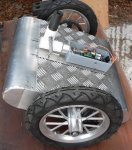happytriger2000
Member
While I'm waiting for the new chips arrival, I thought I'll post another thread that I plan to do that is the Picaxe based Segway.
Gathered some information from Elektor Electronics magazines June, July/August, September issues about Elektor Wheelie a segway alike, and there were some free source in it, I could not attach the zip file probably cos is too large, so goto this link for download: http://www.badongo.com/file/26644591
I added 3 extra files in the 080718-11-v2.6 folder which were the PCB frabrication parts link: http://www.badongo.com/file/26644626
Open attachment for the part list used in Elektor wheelie,View attachment Components.txt
Anyone interested in building this projects in Picacaxe?
Please suggest a suitable Picaxe board for this project, thx
Gathered some information from Elektor Electronics magazines June, July/August, September issues about Elektor Wheelie a segway alike, and there were some free source in it, I could not attach the zip file probably cos is too large, so goto this link for download: http://www.badongo.com/file/26644591
I added 3 extra files in the 080718-11-v2.6 folder which were the PCB frabrication parts link: http://www.badongo.com/file/26644626
Open attachment for the part list used in Elektor wheelie,View attachment Components.txt
Anyone interested in building this projects in Picacaxe?
Please suggest a suitable Picaxe board for this project, thx


